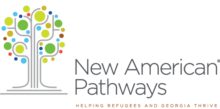By: Brittany Gilliland
There are four languages mingling in the room, perhaps more if you count the baby babble. However, all the languages here share one thing in common: they are working to share simple, yet vital information about the United States.
Cultural orientation at New American Pathways is one of the first experiences our clients, a mixture of refugees and immigrants, have with our office once they’ve arrived in the United States — it’s also a hallmark of intern experience here. This orientation serves the families that have arrived within the previous week. Most of them have had an incredibly long journey to get into the seats of this room. This week there were almost thirty people, but the largest known session had nearly sixty.
As a visitor, I found there were many pieces of information included in cultural orientation that in my daily life I’ve never thought too much about. I took for granted that, from an early age, I knew most federal and state regulations, such as having to get a driver’s license in order to operate a vehicle. I realized that many of those in the room might not have previously been required to go to a DMV or to even take a driving test. I also took for granted knowing how to navigate my own healthcare system, from the mass amounts of paperwork for a preliminary doctor’s visit to how long the wait can be inside a possibly packed and loud waiting room.
Cultural orientation spans a roughly two-hour time frame and encompasses two PowerPoint slideshows, three language translations (in the session I attended), and numerous questions. The first slideshow highlights health screenings while the second covers almost everything else, such as services New American Pathways provides, the role of clients, finances and, my personal favorite, the new community. The new community portion of the presentation focuses on public spaces, such as libraries, public laundries, community centers and places for religious observance.
While all the information I took in was recognizably important, the sheer amount of it over those two hours was overwhelming. If I hadn’t already known most of the information, or it had to be translated for me, I’m not sure how well I would have done trying to learn it all. However, thirty New American took in all that information within two hours, possibly overwhelmed, but finally safe. In two hours, everyone there began an official transition into our community.
